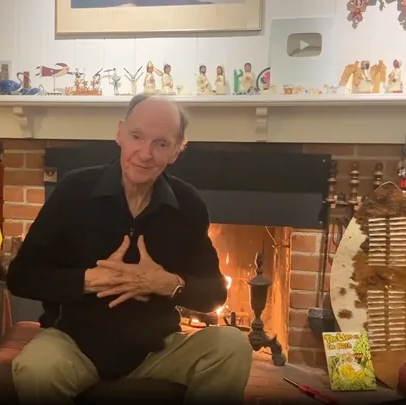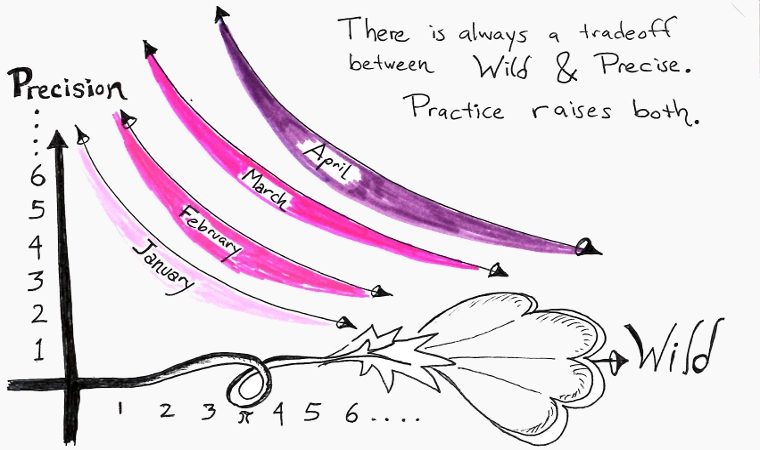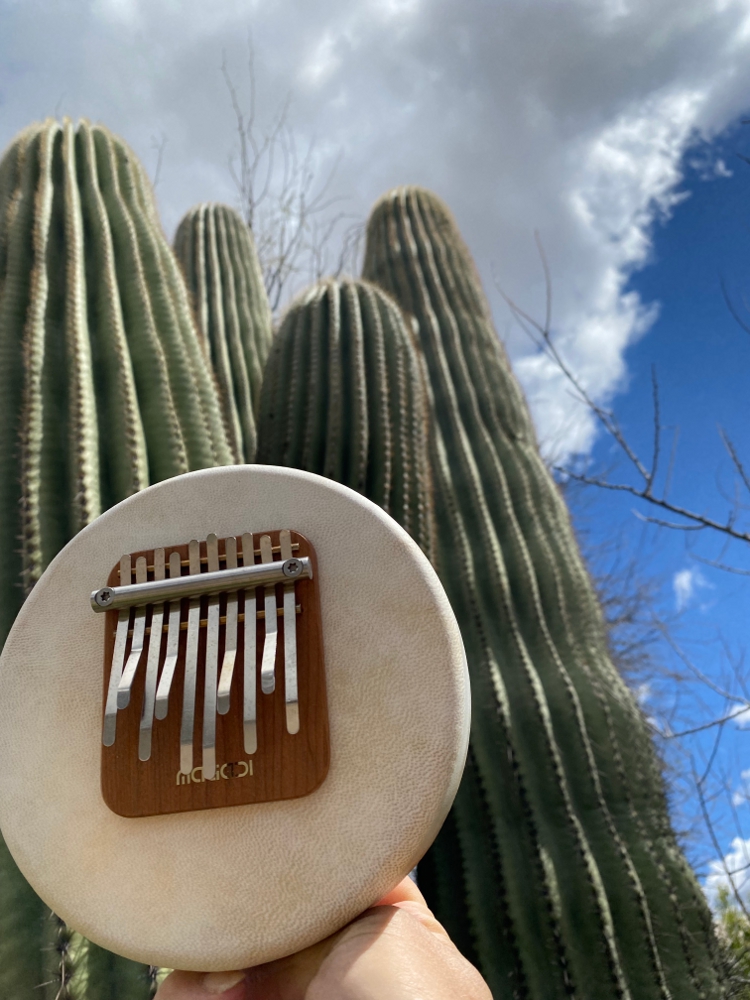
Use of this website constitutes acceptance of the Privacy Policy and User Agreement. Copyright © 2020 Kalimba Magic. All Rights Reserved.
I was speaking last night with my neighbor Geo, when he said: “Somewhere between the party animal I was in my marriage and the zen meditator I’ve been in my current relationship… is the real Geo.”
I could see the axis, drawn in space before our eyes: on one end of the imaginary “number line” was Geo as Beer-Drinking-Good-Timing-Party-Animal… and at the other end was Geo as Peaceful-Meditating-Man. And Geo’s quest right now was to feel along this axis and understand where he belongs.
In my opinion, he exists all along that axis, occupying different places at different times, as everyone does.
And the very same thing applies to wildness and precision in your kalimba playing.
Earlier today, when it was time to go to work, instead of recording, instead of working to fill orders, I seemed to be frozen between all the different directions I should be working. There is one thing that I know I can do to remedy the paralysis that threatens to engulf me in such moments: PLAY KALIMBA!
Playing the kalimba calms me and helps me feel better, and puts all of those other demands in perspective. And in playing kalimba, I am repeatedly reminded that in order to make progress in any one of these endeavors, I must direct all of my attention to that one thing. I can only do one thing at a time, and right now it is KALIMBA, and what a joy it is, to progress in this constant, yet constantly changing thing in my life.
And as I played, my focus changed, back and forth between far away and close up.
Focusing far away, I could feel the raw emotion of the piece of music I was working on. The precise thumb motions didn’t matter so much. I made more little mistakes, but I seemed to capture the big picture. I did not “space out” – rather, I “spaced in” to the music…
Until I hit a sort of brick wall. I made one little mistake that my faraway gaze permitted to continue… which resulted in another error, and then whole phrases of notes came crashing down around my feet and I just stopped playing.
This is a new kalimba I am working on – the Mbira Style Treble Kalimba. Its layout is sort of a simplification and abstraction of the mbira note layout. But the tines on the treble are very close together. On this particular kalimba, the left and right sides each play an independent scale and adjacent notes in the scale are on adjacent tines. So if you are sloppy and miss a note by one tine, it likely wouldn’t even harmonize with the intended note and can only be called an error.
In a few months, when I am more familiar with the Mbira Style Treble, I will be able to shift into that far-away gaze and take in with precision exactly what left and right are doing; when I become totally relaxed on this instrument, I will be able to see the two separate operations at once. But right now, I only seem to be able to look at the left thumb… or the right thumb… but not at both.
It is then that I tighten my focus on the kalimba, and “zoom in,” first on the left thumb for 6 beats… then to the right thumb. I see exactly the note pattern I desire to accomplish. It is clear in my mind’s eye, until… a momentary distraction interferes, and I miss a note, miss a change. And then I draw in again to a tighter focus on exactly what I am trying to accomplish.
Precision in space and time. If you move a thumb to a slightly incorrect place, you hit two tines instead of one, or the wrong tine altogether. If you play slightly early or slightly late, the rhythm is sloppy or plain incorrect. Sometimes when a player slips and makes an error, they may become flustered or discouraged. They may lose focus or intention, and the music suffers. And if an audience senses that the player is not in control of the instrument, they may not pay such close attention.
If I make a mistake, I look to exactly how my thumb nails are touching the tines, but in the next cycle… I make the error again! So it is not just precision in space and time… it is also about precision of perception and understanding. It is about mastering one’s mind and body.
I might have gotten frustrated, but instead, the intense attention I was paying pays off – I realize “Oh, my thumb nails are pretty big, and these tines are pretty close together… but if I rotate my thumb a little this way… and tip my nail down that way… it makes an easier contact with each single intended tine.”
Pay attention! Together, this instrument and your body will teach you.
But as I tightened my attention on the details and minute workings of the kalimba, I lost my fire. The music was indeed precise, by it had gotten really quiet. I was now doing it right, playing exactly the right notes at the right time, and my wildness had dropped out of sight.
Of course, I want to play with intensity, strength, wildness, raw emotion, and power. But I also want to play the right notes.
Like Geo on his axis, we can be in different places at different times, and sometimes more here than there. Progressing with music doesn’t happen in a linear fashion. At any given instant, I might have a trade off between wildness and precision, but over time my playing can evolve depth and complexity where both freedom and rigor live easily together in my music.

By going back and forth between wildness and precision in my kalimba process, i am developing my wildness and precision “muscle” that I can strengthen through practice.
After I pay keen attention to the details of what notes I should be playing, I shift my gaze again to far away. After having reminded my body what it needs to do, and exactly how, I slow down a bit and let it do its thing. I trust it to do this right. And as I get through one cycle, two cycles, three cycles without error, my wild factor begins to come into play again. I feel emotion growing. I feel my thumbs play with more strength. Some subtle meaning beyond just the details of the notes starts to come through the music and my thumbs move a little faster… and I’m in the groove.
For a while anyway. Until the next time my wildness gets me into trouble.
I am a fundamentally lazy individual. I would rather not exert the mental energy required to go into that place of precision, of detailed understanding and detailed accomplishment. But the way to get better IS to go to that place of detail and precision.
But as I go back and forth and exercise this muscle, over time I find that I can play a piece of music (both practiced and improvised) with more precision and more wildness than I could have, had I not worked it the way I do.
Eventually, after many episodes of my attentive mind pulling me back in to the details, to correct or refresh, my thumbs learn the way themselves. At this point, I can let go and do not need to hold on with my mind – I can go wild and just play, and I recalibrate my focus. Instead of being the tight controller of the detail, my mind can look to a grander picture of what this music could be, and work to push my thumbs further, far beyond just getting the notes right.
I imagine that this is a wonderful way to keep my mind and thumbs nimble well into old age.


Sign up for our newsletter and free resources with your email address:
We pinky promise not to spam you and to only send good stuff.
 Assist Paul Tracey Rebuild His House in Pacific Palisades
Assist Paul Tracey Rebuild His House in Pacific Palisades 8-Note Spiral Kalimba Turned into a Student Karimba
8-Note Spiral Kalimba Turned into a Student Karimba Seek to Infuse Your Musical Moments With Beauty and Magic
Seek to Infuse Your Musical Moments With Beauty and MagicUse of this website constitutes acceptance of the Privacy Policy and User Agreement. Copyright © 2020 Kalimba Magic. All Rights Reserved.